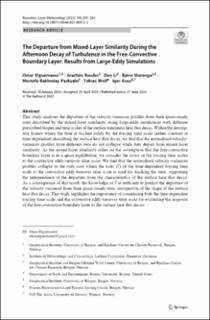| dc.contributor.author | Elguernaoui, Omar | |
| dc.contributor.author | Reuder, Joachim | |
| dc.contributor.author | Li, Dan | |
| dc.contributor.author | Maronga, Bjørn | |
| dc.contributor.author | Bakhoday Paskyabi, Mostafa | |
| dc.contributor.author | Wolf, Tobias | |
| dc.contributor.author | Esau, Igor | |
| dc.date.accessioned | 2023-08-07T08:34:01Z | |
| dc.date.available | 2023-08-07T08:34:01Z | |
| dc.date.created | 2023-07-10T14:48:10Z | |
| dc.date.issued | 2023 | |
| dc.identifier.issn | 0006-8314 | |
| dc.identifier.uri | https://hdl.handle.net/11250/3082806 | |
| dc.description.abstract | This study analyses the departure of the velocity-variances profiles from their quasi-steady state described by the mixed-layer similarity, using large-eddy simulations with different prescribed shapes and time scales of the surface kinematic heat flux decay. Within the descriptive frames where the time is tracked solely by the forcing time scale (either constant or time-dependent) describing the surface heat flux decay, we find that the normalized velocity-variances profiles from different runs do not collapse while they depart from mixed-layer similarity. As the mixed-layer similarity relies on the assumption that the free-convective boundary layer is in a quasi-equilibrium, we consider the ratios of the forcing time scales to the convective eddy-turnover time scale. We find that the normalized velocity-variances profiles collapse in the only case where the ratio (r˜) of the time-dependent forcing time scale to the convective eddy-turnover time scale is used for tracking the time, supporting the independence of the departure from the characteristics of the surface heat flux decay. As a consequence of this result, the knowledge of r˜ is sufficient to predict the departure of the velocity variances from their quasi-steady state, irrespective of the shape of the surface heat flux decay. This study highlights the importance of considering both the time-dependent forcing time scale and the convective eddy-turnover time scale for evaluating the response of the free-convective boundary layer to the surface heat flux decay. | en_US |
| dc.language.iso | eng | en_US |
| dc.publisher | Springer | en_US |
| dc.rights | Navngivelse 4.0 Internasjonal | * |
| dc.rights.uri | http://creativecommons.org/licenses/by/4.0/deed.no | * |
| dc.title | The Departure from Mixed-Layer Similarity During the Afternoon Decay of Turbulence in the Free-Convective Boundary Layer: Results from Large-Eddy Simulations | en_US |
| dc.type | Journal article | en_US |
| dc.type | Peer reviewed | en_US |
| dc.description.version | publishedVersion | en_US |
| dc.rights.holder | Copyright 2023 the authors | en_US |
| cristin.ispublished | true | |
| cristin.fulltext | original | |
| cristin.qualitycode | 1 | |
| dc.identifier.doi | 10.1007/s10546-023-00812-2 | |
| dc.identifier.cristin | 2161724 | |
| dc.source.journal | Boundary-Layer Meteorology | en_US |
| dc.source.pagenumber | 259-284 | en_US |
| dc.identifier.citation | Boundary-Layer Meteorology. 2023, 188, 259-284. | en_US |
| dc.source.volume | 188 | en_US |

